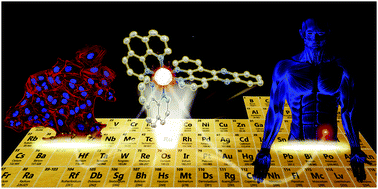当前位置:
X-MOL 学术
›
Chem. Soc. Rev.
›
论文详情
Our official English website, www.x-mol.net, welcomes your feedback! (Note: you will need to create a separate account there.)
The development of ruthenium(ii) polypyridyl complexes and conjugates for in vitro cellular and in vivo applications
Chemical Society Reviews ( IF 46.2 ) Pub Date : 2017-11-27 00:00:00 , DOI: 10.1039/c7cs00680b Fergus E. Poynton 1, 2, 3, 4, 5 , Sandra A. Bright 2, 3, 4, 5, 6 , Salvador Blasco 1, 2, 3, 4, 5 , D. Clive Williams 2, 3, 4, 5, 6 , John M. Kelly 2, 3, 4, 5, 7 , Thorfinnur Gunnlaugsson 1, 2, 3, 4, 5
Chemical Society Reviews ( IF 46.2 ) Pub Date : 2017-11-27 00:00:00 , DOI: 10.1039/c7cs00680b Fergus E. Poynton 1, 2, 3, 4, 5 , Sandra A. Bright 2, 3, 4, 5, 6 , Salvador Blasco 1, 2, 3, 4, 5 , D. Clive Williams 2, 3, 4, 5, 6 , John M. Kelly 2, 3, 4, 5, 7 , Thorfinnur Gunnlaugsson 1, 2, 3, 4, 5
Affiliation

|
Ruthenium(II) [Ru(II)] polypyridyl complexes have been the focus of intense investigations since work began exploring their supramolecular interactions with DNA. In recent years, there have been considerable efforts to translate this solution-based research into a biological environment with the intention of developing new classes of probes, luminescent imaging agents, therapeutics and theranostics. In only 10 years the field has expanded with diverse applications for these complexes as imaging agents and promising candidates for therapeutics. In light of these efforts this review exclusively focuses on the developments of these complexes in biological systems, both in cells and in vivo, and hopes to communicate to readers the diversity of applications within which these complexes have found use, as well as new insights gained along the way and challenges that researchers in this field still face.
中文翻译:

用于体外细胞和体内应用 的钌(ii)聚吡啶基配合物和偶联物的开发
自从工作开始探索钌(II)[Ru(II)]多吡啶基复合物与DNA的超分子相互作用以来,它一直是研究的重点。近年来,为了开发新型的探针,发光显像剂,治疗剂和治疗诊断学,已经做出了巨大的努力将这种基于溶液的研究转化为生物环境。在仅仅十年的时间里,随着这些复合物作为显像剂和有希望的治疗学候选者的广泛应用,该领域得到了扩展。鉴于这些努力,本文仅着眼于生物系统在细胞和体内的这些复合物的发展。,并希望与读者交流这些复合体在其中得到广泛应用的各种应用,以及在这一领域的研究人员仍然面临的方式和挑战中获得的新见解。
更新日期:2017-11-27
中文翻译:

用于体外细胞和体内应用 的钌(ii)聚吡啶基配合物和偶联物的开发
自从工作开始探索钌(II)[Ru(II)]多吡啶基复合物与DNA的超分子相互作用以来,它一直是研究的重点。近年来,为了开发新型的探针,发光显像剂,治疗剂和治疗诊断学,已经做出了巨大的努力将这种基于溶液的研究转化为生物环境。在仅仅十年的时间里,随着这些复合物作为显像剂和有希望的治疗学候选者的广泛应用,该领域得到了扩展。鉴于这些努力,本文仅着眼于生物系统在细胞和体内的这些复合物的发展。,并希望与读者交流这些复合体在其中得到广泛应用的各种应用,以及在这一领域的研究人员仍然面临的方式和挑战中获得的新见解。


























 京公网安备 11010802027423号
京公网安备 11010802027423号